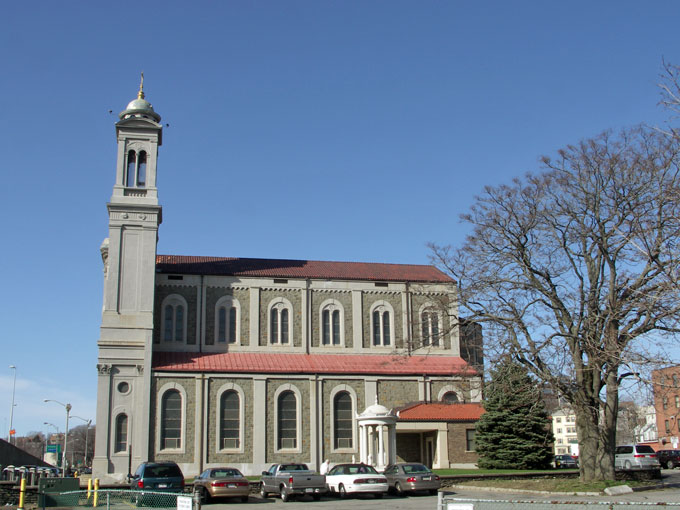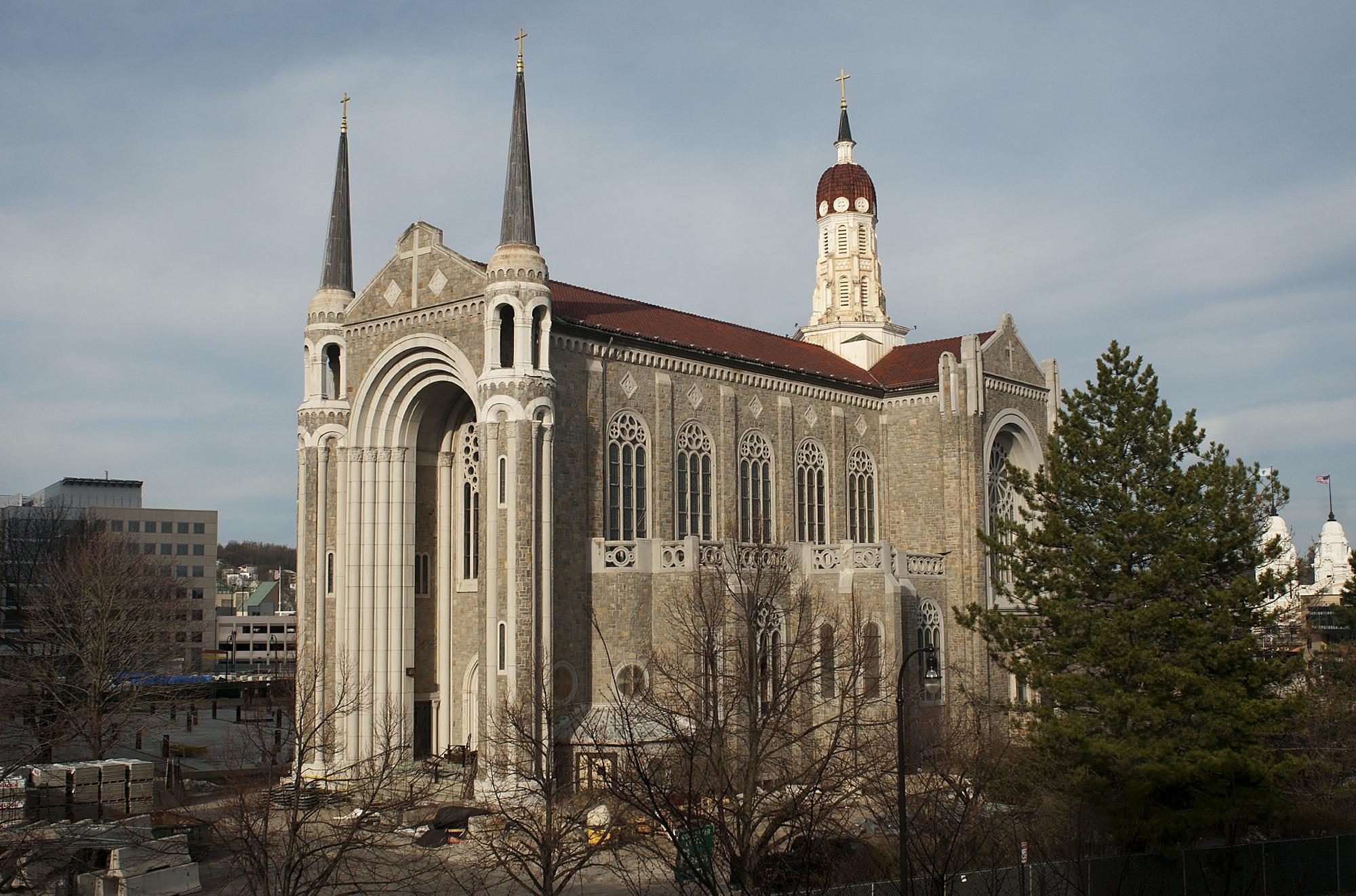Maybe this is no coincidence: This June, two of our iconic, historic Worcester churches, Our Lady of Mount Carmel on Mulberry Street and Notre Dame des Canadiens in downtown, are pending hearings for their immediate demolition. At the Worcester Historical Commission meetings, the petitioners, the Catholic Diocese of Worcester for Mt. Carmel on June 9th and the developers of City Square for Notre Dame on June 30th, are requesting waivers from the one year waiting period for demolition orders. Their goal: Tear down right away. The Diocese is arguing that Mt Carmel poses a safety hazard, the building’s façade potentially crumbling onto drivers on closely adjacent route 290. The City Square developer claims that there is no economically viable reuse for Notre Dame and that its presence becomes a barrier to the successful on-time completion of the City Square project.
Who will speak for the churches? Since Reverend Monsignor Stephen Pedone’s abrupt announcement of Mt. Carmel’s closure on May 1st, congregants and friends have quickly organized a “Save Mt. Carmel” campaign, questioning the motives of the Diocese in the move to close and immediately demolish the church. Unable to bear the costs of maintaining the structure, the congregants of Notre Dame sold the building to the City Square developers in 2010 and have long since moved on from the building. Only those who believe in the importance of historic preservation and those who are Jane Jacobs in the Woo are left to speak for Notre Dame des Canadiens.
“Cities need old buildings so badly it is probably impossible for vigorous streets and districts to grow without them.”
So now, let Jane Jacobs in the Woo speak out!
As communal anchors, churches are true symbols of thriving neighborhoods. These are public spaces where neighbors gather together to mark passages of life – births, marriages, coming of age ceremonies, death and just to share rituals related to the changing of the seasons and years. Healthy, living neighborhoods have churches and other communal spaces of worship! So, when a church dies for whatever reason, it becomes a literal and symbolic death of a living community.
Urban renewal beginning in the 1950s is a clear antecedent for the demolition hearings of these two churches this month. Let’s look at each case:
Our Lady of Mount Carmel: In 1957, land takings and clearance of neighborhoods began in earnest to make room for the building of a highway for commuters to gain access to downtown Worcester. Route 290, a 23 mile stretch from Auburn to Marlborough straight through Worcester, was finally completed in 1970. The Italian enclave off of Shrewsbury was spared major disruption of their neighborhood since the road edged along the outskirts. However, according to historian John Anderson, post 290 construction, the presence of the highway gave neighborhood residents the sense of being cut off and separated from the downtown core. Our Lady of Mt Carmel, the spiritual heartbeat of this Italian Catholic neighborhood, amazingly survived the wrecking ball. Known as “Our Lady of the Highway,” the building sits perched adjacent to the highway, its main towers greeting the thousands of drivers speeding past daily. Urban renewal did not originally destroy this neighborhood icon. This has been a slow-kill – over 45 years of toxic highway fumes despoiling the church’s façade.
Driving down 290, one can see the crumbling facade of Mt. Carmel Church. Known as "Our Lady of the Highway", this church is showing the impact of 40 plus years of highway fumes on its structure. The church is a good example of the "slow-kill" of urban renewal.
Notre Dame des Canadiens: This church has staying power! During the first urban renewal craze in the 1960s, the church was one of the only remaining structures not destroyed to make room for the Worcester Center Galleria that opened in 1971. Most of the mixed use, historic infrastructure razed at the time, served as the backdrop to a living downtown. People lived, worked, shopped, socialized and yes, prayed in churches downtown. Urban renewal replaced this thriving space with single use mega projects, killing downtown as an actual neighborhood. The mall having failed, the city again looked to outside developers to replace the monolithic structure. It is the same paradigm: Forge partnerships with developers that have no local ties. Clear out huge tracts of land at once. Build single use megaprojects with parking lots. In this case, City Square II Development Co are planning a 350 unit residential development, a Marriott Hotel and of course, a garage for the land currently being cleared. But what about this beautiful, historically rich little church that sits amidst this clearance frenzy? How will Notre Dame survive this onslaught yet another time?
Notre Dame held hostage to the construction happening around it.
Jane Jacobs in the Woo sat patiently at the first demolition hearing of the Worcester Historical Commission on 5/19/16. She listened with an open ear to the City Square developer’s representative requesting a waiver for the one year waiting period so that they could bulldoze the church immediately. The representative was not able to present any documentation of work done in the past six years of ownership to preserve the building or seek out potential future reuse options – no structural engineering studies, no architectural assessments, no examples of potential reuse partnership organizations. The chairman of the Worcester Historical Commission expressed his concern that no heating system was set up, even temporarily to keep the building warm during the winter, potentially resulting in hastened interior damage to the structure. He posed the possibility that improper basic maintenance of the building could constitute “demolition by neglect”. When asked about the use of the site after the demolition of the building, the representative answered that the site would be graded and left empty. In other words, this historic building, an architectural gem would be razed for a currently planned empty lot. This is urban renewal, Worcester! This is how urban renewal has slow-killed our historic, human scaled landscape.
Jane Jacobs in the Woo encourages you to speak or just to witness the demolition hearings of the Worcester Historical Commission on June 9th for Mt Carmel and/or on June 30th for Notre Dame at city hall.



